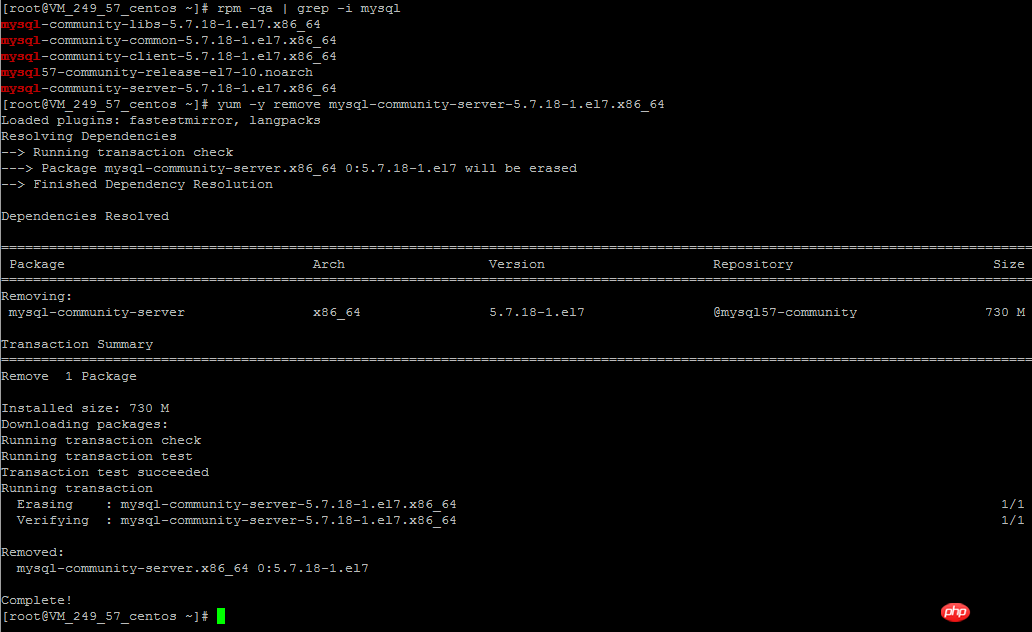
Finally figured out the yum installation process. I have written binary package installation before. Here I use yum to install it. The environment is the same, Centos7.2+MySQL5.7.18. This article mainly introduces MySQL5.7.18 yum under Linux. The method is illustrated from uninstallation to installation. Friends who need it can refer to it. I hope it can help everyone.
Each step refers to many articles, which will be listed one by one later. Because this machine has already been installed, simply follow the steps step by step to uninstall and then reinstall.
This article is implemented through a series of relatively copycat methods. For users like me who have not been exposed to Linux for a long time, it is relatively easy to understand and accept. For example, download the file directly under Windows and drag it to the Linux system. Instead of downloading with wget command, edit directly through the editing function of winscp editor instead of vim command.
Uninstall
Operating system version

rpm -qa | grep -i mysql rpm -qa | grep -i mysql命令查看已经安装过的组件。

Use the yum -y remove command to uninstall the installed MySQL components. Use the following command to uninstall the ones installed above separately.
yum -y remove mysql-community-libs-5.7.18-1.el7.x86_64 yum -y remove mysql-community-common-5.7.18-1.el7.x86_64 yum -y remove mysql-community-client-5.7.18-1.el7.x86_64 yum -y remove mysql57-community-release-el7-10.noarch yum -y remove mysql-community-server-5.7.18-1.el7.x86_64
There will be no more pictures Take a screenshot and take an example.

Use rpm -qa | grep -i mysql again to view the installed components. They have been completely uninstalled.

Whereis MySQL queries the directories generated by previous installation and remove them respectively.

Installation
Download the MySQL repo source. As for what this file does, my personal understanding is to automatically configure the yum source of the MySQL installation component for you. of.
This file can be downloaded under Windows and then uploaded to the Linux server. It can also be downloaded directly from the Linux server. It also needs to be installed.

After downloading this file, drag it to the root directory of the Linux server through winscp

Download the above under Linux The file

Install the MySQL repo package
rpm -ivh mysql57-community-release-el7-10.noarch.rpm

There will be some simple prompts in the middle. After entering Y, Everything is installed fully automatically.
yum install mysql-community-server

Installation completed

Modify Root initial password
After installation, it will be generated under etc A my.cnf file, add a skip-grant-tables = 1 configuration to my.cnf to skip the initial password verification requirement.

Systemctl starts the mysql service

Connect to the MySQL service, because it is configured to skip the password requirement, enter mysql - Press enter after u -p, and continue to press enter when prompted to enter the password to connect to mysql.

Modify the MySQL Root password
update user set authentication_string=PASSWORD('newpassword') where User='root';
Use this statement to modify the root user for remote access, update user set host = '%' where user = 'root'


MySql5.7.18 character set configuration graphic example sharing
Centos7.3 installation mysql5.7.18 rpm tutorial
About centos6.4 mysql5.7.18 installation and configuration method graphic tutorial sharing
The above is the detailed content of Detailed graphic and text explanation of MySQL5.7.18 yum method from uninstallation to installation under Linux. For more information, please follow other related articles on the PHP Chinese website!




